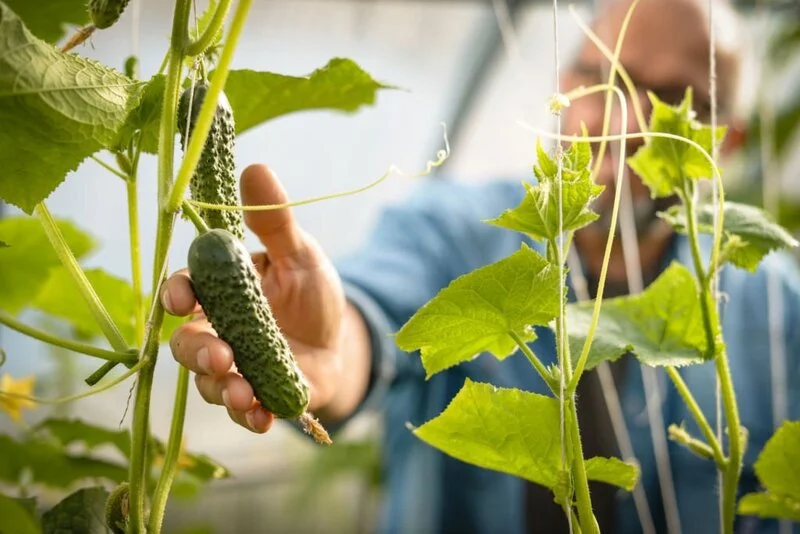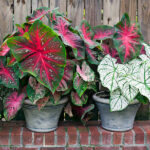Have you been managing your cucumbers and suddenly seen a strange white color develop on them? If you’re used to seeing a bright green, you could be taken aback by this transformation. But you shouldn’t freak out just yet. Several explanations exist for this unexpected shift. The possible causes of your white cucumbers will be discussed in this post.
- High Breed Live Plants in Pots. Indoor or Outdoor Backyard Gardening Vegetable Garden
- New stocks Fast-growing plants from high breed selected seeds
- Will grow up really fast with appropriate care
- Big, deep green vegitables that grow long upto 8″.
- Plants produce multiples or more if kept harvested and well-watered
Understanding Cucumber Growth
Like most plants, cucumbers follow a standard growth pattern. They begin as tiny seeds, grow into tender young plants, and then bear the delicious, crisp fruits we all know and adore. Cucumbers normally have a stunning emerald green color. Young ones are a light, almost yellowish green, but they mature into a dark, rich shade of green. Something is disrupting the normal process if your cucumbers are turning white.
Common Causes of White Cucumbers
There are several causes of white spots on cucumbers. Low levels of sunlight are a common contributor. Sunlight is essential for the development of color in cucumbers, as it is in many other fruits. They may not get enough sunlight in the shaded area to fully develop their green color.
The presence of particular pests or illnesses is yet another potential cause. Cucumbers becoming white might be caused by issues like powdery mildew or a spider mite infestation.
Finally, the cucumbers you grow may be white or extremely pale green depending on the cultivar. In this instance, the color white is acceptable.
If we can identify the root causes of the white spots on our cucumbers, we can work to eliminate them in the future. Let’s go deeper into these explanations.
Lack of Sunlight
Cucumbers, like sunbathers, require exposure to direct sunshine in order to achieve their vibrant green color. Cucumbers that don’t get enough light from the sun’s rays will look pale or even white. In a nutshell, they need to work on their tan! To keep their original hue, cucumbers need to be exposed to sunshine for at least 6-8 hours daily.
Disease and Pests
Unfortunately, cucumbers are susceptible to the same illnesses and pests that affect other plants. Fungal diseases like powdery mildew are a typical source of white spots on fruit. Pests like spider mites can do similar harm, resulting in white spots or a generally pale look. It’s time to take action if you see any white powdery areas or tiny crawling bugs. You can get rid of these problems and restore the cucumbers’ original color by using either organic or chemical treatments, depending on your personal preference.
- FOR ORGANIC GARDENING: Can be used up to day of harvest
- INSECTICIDE/FUNGICIDE/MITICIDE: Three garden products in one
- READY-TO-USE SPRAY: Spray for complete coverage of all plant tissue
- FOR USE ON: Roses, flowers, houseplants, ornamental trees and shrubs, fruits and vegetables
- PREVENTS LISTED FUNGAL DISEASES: Apply weekly to every 2 weeks until the potential for disease is no longer present
Varietal Characteristics
Some varieties of cucumber are intended to have a white color. You read that correctly. White cucumbers are a natural occurrence in several cultivars, such as the ‘White Wonder’ and ‘Albino’ kinds. You need not be concerned if you are cultivating one of these types. Your cukes are just being cucumbers. Before you plant a cucumber patch, familiarize yourself with the specific traits of each variety.
Prevention and Treatment
Sunlight is the first line of defense against white cucumbers. These sun-loving fruits require a sunny area in your garden to grow well. It’s also crucial to perform regular pest and illness checks. Use appropriate therapies immediately if problems arise. There are a variety of organic options for preventing and treating pests and diseases in your garden. Keep in mind that your white cucumbers are just being themselves if you bought a naturally white kind.
- Effective 20 Pack Sticky Traps are suitable to use indoors or outdoors.
- Specially designed for flying plant pests. Great to attract whiteflies, fungus gnats, blackflies, thrips, fruit flies, midges and other flying insects.
- ECO friendly materials, safe and Non-toxic. reduce the use of chemical insecticides.
- Dimension: 20 Pack 6*8 inches
- Easy to Use. UV Resistant adhesive will not dry up, waterproof,heat resistant,can be used for any crop in any season.
Conclusion
It’s not something you expect to see white cucumbers growing in your yard. As we’ve seen, though, there are a number of factors that can contribute to this, including a lack of sunlight, annoying infections, or even the variety you planted. If you know what causes your cucumbers to turn yellow, you can take steps to stop it or reverse it. All the best with your gardening endeavors!







